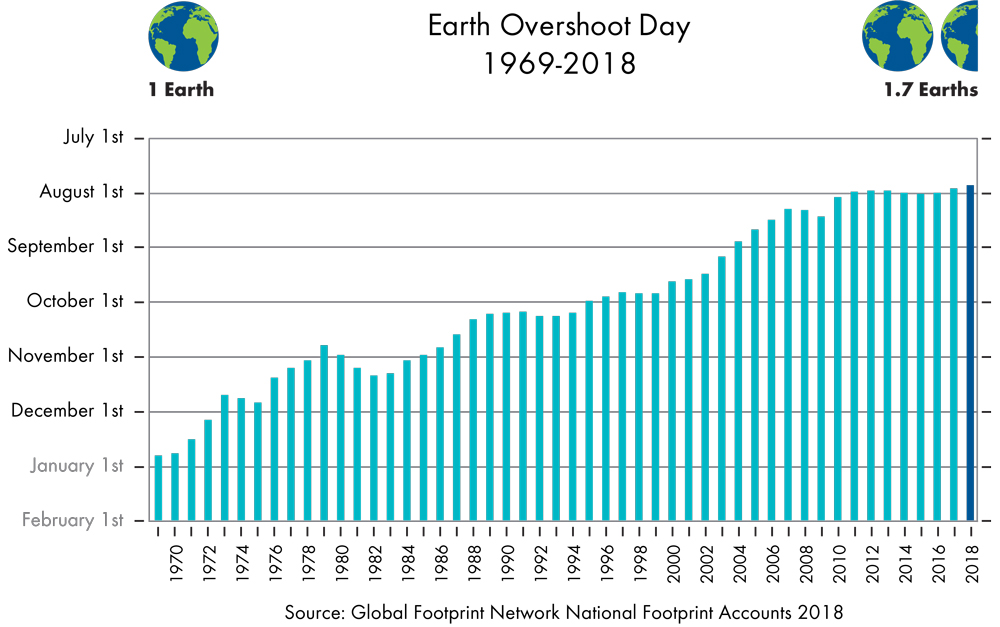Every year, conflicting and confusing accounts of past Earth Overshoot Day dates sprout in media reports and in the blogosphere. Here’s our latest attempt at clarifying this matter, with a view to putting misunderstandings to rest.
The date of Earth Overshoot Day is calculated by comparing humanity’s total yearly consumption (Ecological Footprint) with Earth’s capacity to regenerate renewable natural resources in that year (biocapacity).
Global Ecological Footprint and biocapacity metrics, in turn, are calculated each year with National Footprint Accounts. Using UN statistics, these accounts incorporate the latest data and the most updated accounting methodology (the National Footprint Accounts 2018 Edition feature 2014 data.) To estimate this year’s Earth Overshoot Day, Ecological Footprint and biocapacity are “nowcasted” to the current year using the latest data from additional sources, such as the Global Carbon Project and others.
To maintain consistency with the latest reported data and science, the Ecological Footprint metrics for all past years since 1961 (the earliest year data is available) are recalculated every year, so each year’s metrics share a common data set and the exact same accounting method. The annual dates of Earth Overshoot Day are recalculated accordingly.
Consequently, it is inaccurate to simply look at media accounts from previous years to determine past Earth Overshoot Days. Indeed, a true apples-to-apples comparison of Earth Overshoot Days can only be made using the same edition of the National Footprint Accounts. For instance, it would make no sense to compare the date of Earth Overshoot Day 2007 as it was calculated that year—and reported by the media at the time—with the date of Earth Overshoot Day 2018, because improved historical data and new findings such as lower net carbon sequestration by forests have slightly shifted the results. Even a few percentage points change can shift the date of Earth Overshoot Day by a good number of days.
This is why, ultimately, the precise Earth Overshoot Day date for each year is less significant than the sheer magnitude of the ecological overshoot, as well as the overall trend of the date progression year over year—which, as you now understand, is rigorously identical to that of the Ecological Footprint (given the fact that biocapacity remains basically unchanged.) Over the last decades, the date has been creeping up the calendar every year, although at a slowing rate. This is what it looks like:
(click image to view larger version)
The dates of past Earth Overshoot Days, as calculated with the National Footprint Accounts 2018 Edition, are:
December 29, 1970
December 20, 1971
December 9, 1972
November 26, 1973
November 27, 1974
November 30, 1975
November 16, 1976
November 10, 1977
November 7, 1978
October 29, 1979
November 3, 1980
November 11, 1981
November 15, 1982
November 14, 1983
November 6, 1984
November 4, 1985
October 30, 1986
October 23, 1987
October 15, 1988
October 12, 1989
October 11, 1990
October 10, 1991
October 13, 1992
October 13, 1993
October 11, 1994
October 5, 1995
October 2, 1996
September 30, 1997
September 30, 1998
September 30, 1999
September 23, 2000
September 22, 2001
September 19, 2002
September 9, 2003
September 1, 2004
August 26, 2005
August 20, 2006
August 14, 2007
August 15, 2008
August 19, 2009
August 8, 2010
August 4, 2011
August 4, 2012
August 4, 2013
August 5, 2014
August 6, 2015
August 5, 2016
August 3, 2017
August 1, 2018

